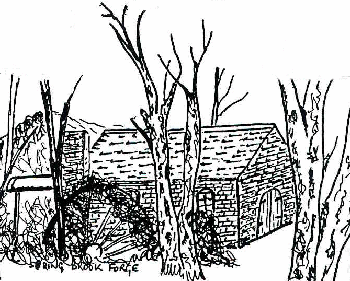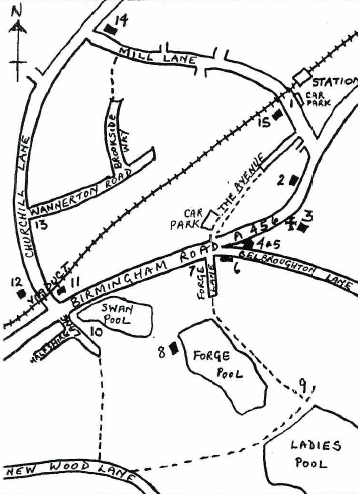WALKS AROUND HAGLEY: WALK No.1 BLAKEDOWN
DISTANCE: JUST UNDER TWO MILES. TIME ONE & HALF HOURS. PARK IN BLAKEDOWN AND COMMENCE THE WALK AT THE STATION (O.S. MAP GRID. REF. 881787)
The Station The railway was built in 1852 by the Oxford, Worcester and Wolverhampton Railway Company, known to locals from its initials and many misfortunes, as the Old Worse and Worse. Walk to the main road (A456) and turn right.
Little Champson A short way on the right is a house, Little Champson, built in 1835. The first owner was a gentleman farmer from Great Champson, in Gloucestershire. The original front door was probably blocked in. 
The Church Cross the main road (with care) and you find the Church on your left. The Church of St. James the Great was built as a Chapel of Ease in 1860 (for the ease of those who previously had to travel to St. John's Church in Hagley). The old school lies behind the Church. This school was established in 1885. The architect was Mr. T. Grazebrook and cost £.
Village Street Walk along the main road towards Kidderminster as far as the junction with Belbroughton Road. On the left hand side is Rose Cottage (1820) which was a shop until 1955. Sylvester's Grocery shop used to be on the corner on the site of the Toll House. A Toll Gate once blocked the road here, where the Birmingham - Blakedown Turnpike ended. The haulier, Mr. Hyde, took axles from Spring Brook Forge to the Station along Forge Lane and The Avenue, which he constructed to avoid paying tolls of a half a penny a load.
The Honey Farm Just round the corner in Belbroughton Road, and linked to Rose Cottage (in 1977 the two were joined by roofing over the central cobbled yard) is the Honey Farm. This was a Blacksmith's in 1900. The small window was the brazier and the large window was the stable door. (Note brackets) In the. Second World War it was a builder's yard. The Honey Farm was set up in 1950 and by 1976 Honey was being processed here from 600 hives in Herefordshire, Shropshire, Worcestershire and Staffordshire. 
White Cottages (2 & 4 Belbroughton Road.) Cross Belbroughton Road to the white cottages. These were built c. 1837. The single storied building was previously a slaughterhouse; inside is a (now concealed) main timber post to which animals used to be attached. Turn into Forge Lane, between the cottages and "The Old House at Home".
Forge Lane Walk along Forge Lane past "The Old House at Home" (first licensed in 1873) on the right are some old cottages. There were once more cottages but these were demolished for extensions to "The old House at Home". 2, 4 & 6 Forge Lane were built for workers at the forge. Forge Lane is a regulation l8 feet width, as decreed by the 1832 Enclosure Act. Continue along the lane to Forge Pool. (This is hidden by the trees).
Spring Brook Forge A glimpse of Spring Brook Forge across the pool and through the trees (in Winter), makes it seem incredible that, at the turn of the century, 150 men were employed there. It is a listed building and private property. In the distance you may just be able to see race, sluice, pentrough and wheel.
Forge Pool & Ladies Pool Follow the footpath along the edge of Millennium Green and parallel to Forge Pool. The pool ends in a marshy area. At the edge of this there are coppiced alder trees in the mixed woodland. Turn right at the "T" junction with the next path and cross the dam to the Ladies Pool. There was a flood in 1848 when this dam burst. Fortunately the Forge Pool held the water for 15 minutes, warning reached people downstream and there was no loss of life. N.B. The notice board by the Ladies Pool gives some of the history of the pools and the wildlife.
Halfshire Lane & Swan Pool Continue uphill on this path leading to New Wood Farm (10 feet wide as specified on the 1832 Enclosure Act.). Turn right on reaching New Wood Lane and shortly right again down the bridle path. The raised banks and hedges on each side suggest a boundary. As the path meets Halfshire Lane the Swan Pool can be clearly seen on your right and across the pool look along the Viaduct to your right to see the remains of the red brick supports for the earlier wooden Viaduct. On the left is a modern garage marking the sight of the Smithy at the bottom of Halfshire Lane. This lane was originally part of the main road from Blakedown to Kidderminster prior to the Turnpike Road of 1777, which linked Kidderminster to the Blakedown Birmingham Turnpike Road of 1753.
Viaduct Cross the A456, to the left of Churchill Lane a modern black and white house replaces an old timber framed building. Along the Viaduct here is another red brick support of the old wooden Viaduct. On the right hand side of the lane Mill Cottage (modern building) garden now has a dry brick conduit coming under the road from Swan Pool. Blakedown Mill disappeared from this place in the road widening done c.1920.
Viaduct & Other Old Sites Pass under the Viaduct. On the left was Blakedown Sawmill (private property) originally this was on an island made by the stream from Churchill (still visible) and the tail race (now dry) from Blakedown Foundry. This was in operation up till 1951. 
Churchill Lane to Mill Lane You can continue along Churchill Lane to the Mill, but to avoid dangerous traffic in the narrow lane, turn right into Wannerton Road. A short way along is Wannerton Brook. Next turn left into Brookside Way. A path leads from the end of Brookside Way to Mill Lane. Turn left at Mill Lane to see Churchill Corn Mill.
Churchill Corn Mill The dam survives in the garden, a 52m. (57yds.) horse-shoe of brick and earth construction (details in "Watermill sites in North Worcestershire). The mill machinery was sold for scrap in 1940. Window arches suggest an early 19th century date. Large and small millstones left in the garden suggest both corn milling and edge tool grinding.
Return to the Station Walk back along Mill Lane to Blakedown Station. Across the railway lines and to your right are railway cottages. These were built to house the Station Master and Porter. Later they were also used to house the Signalman. In 1994 a Signalman still lived in one of the cottages.
 1
1
